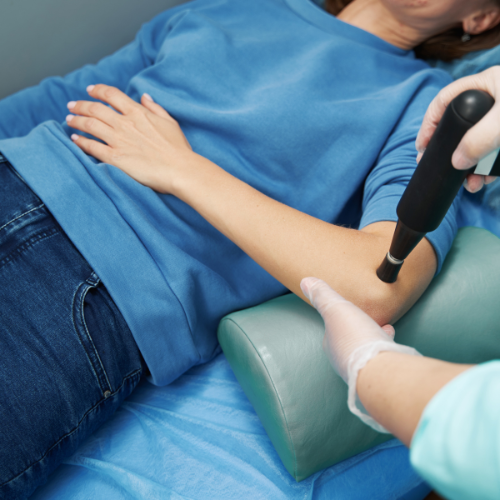Shockwave Therapy in Pensacola: Non-Invasive Pain Relief
Pensacola, Florida, is a city known for its beautiful beaches and vibrant community. However, like anywhere else, residents in Pensacola can experience chronic pain. The good news is that there’s a non-invasive solution in town Shockwave Therapy. This advanced treatment is gaining popularity for its effectiveness in providing relief from various musculoskeletal conditions.

Defining Shockwave Therapy
Shockwave Therapy, also recognized as Extracorporeal Shock Wave Therapy (ESWT), is a cutting-edge medical treatment that uses high-energy sound waves to encourage the healing process within the body. It is a non-invasive procedure that offers a natural alternative to traditional surgical interventions for a wide range of conditions, particularly those involving the musculoskeletal system.
How does Shockwave therapy work?
Shockwave therapy at Injury Helpline Florida is a non-invasive medical therapy that uses high-energy sound waves to encourage the body’s natural healing processes. It is commonly used to treat various musculoskeletal conditions, including tendinitis, plantar fasciitis, and muscle strains. Here’s an overview of the process of shockwave therapy:
1. Starting Discussion:
The first step is to consult with a qualified healthcare provider who specializes in shockwave therapy. Starting discussion is essential to assess your condition and determine if shockwave therapy is an appropriate treatment option for you.
2. Assessment and Diagnosis
During the consultation, the healthcare provider will assess your medical background, carry out a physical examination, and possibly use imaging tests like X-beams or ultrasounds to diagnose the specific condition and pinpoint the exact location of the issue.
3. Treatment Arranging
In light of the appraisal, assessment and diagnosis, the healthcare provider will make a customized treatment plan. This arrangement will outline the quantity of shockwave therapy sessions required, the frequency of treatment, and the intensity of the shockwaves.
4. Preparation
Before the treatment begins, the patient may be asked to wear appropriate clothing to expose the area being treated. The treatment area is typically cleaned, and a gel or lubricant may be applied to facilitate the transmission of shockwaves.
5. Shockwave Application
The shockwave therapy device delivers high-energy sound waves to the target area. These sound waves are generated by a specialized handheld device and directed precisely to the site of the musculoskeletal issue. During the procedure, the healthcare provider will move the device over the treatment area, delivering shockwaves at regular intervals.
6. Treatment Duration
A typical shockwave therapy session may last 10 to 20 minutes, but the time can change depending on the condition being treated and the provider’s recommendations. Several sessions may be required for a few weeks.
7. Sensations During Treatment
Patients often experience a sensation of pressure or mild discomfort in the area of treatment during the procedure. While it may cause some discomfort, it is generally tolerable, and patients do not typically require anesthesia or sedation.
8. Post-Treatment Care
After each shockwave therapy session, patients can usually resume their normal activities. Some healthcare providers may recommend rest or modified activity levels for a brief period following treatment. Pain relief or improved mobility may not be immediately noticeable and may require some time to take effect as the body’s natural healing processes are stimulated.
9. Follow-Up Appointments
Depending on the treatment plan, patients will return for subsequent shockwave therapy sessions as prescribed by their healthcare provider. Follow-up appointments are crucial to monitor progress and make any necessary adjustments to the treatment plan.
10. Recovery and Results
Over the following weeks and months, the patient should experience pain relief, improved mobility, and healing of the treated area. The full results of shockwave therapy may become more evident with time as the body continues to repair and regenerate damaged tissues.
Benefits of Shockwave Therapy
Here are the advantages of shockwave therapy:
- Shockwave therapy is non-invasive, meaning it does not require incisions, anesthesia, or surgery.
- Shockwave therapy is highly effective in providing pain relief. It can alleviate chronic pain associated with conditions like tendinitis, plantar fasciitis, and calcific shoulder tendinopathy.
- By promoting the body’s natural healing processes, shockwave therapy can enhance mobility and function in the treated area.
- Shockwave therapy stimulates increased blood flow to the affected area, which, in turn, accelerates the body’s natural healing processes.
- Shockwave therapy provides a non-pharmacological approach to pain management.
- Each patient’s condition is unique, and shockwave therapy can be tailored to address individual needs. Healthcare providers can adjust the treatment parameters, such as shockwave intensity and frequency, to ensure the best possible outcomes.
- Shockwave therapy has demonstrated success in clinical trials and real-world applications for a wide range of musculoskeletal conditions. Many patients experience significant pain relief and functional improvement.
- The benefits of shockwave therapy are not just short-term. The therapy often provides long-lasting relief, reducing the risk of recurrent or chronic pain in the treated area.
- For many patients, shockwave therapy offers a non-surgical alternative to address musculoskeletal issues that might otherwise require invasive procedures.
- Shockwave therapy is effective for conditions affecting tendons, ligaments, muscles, and bones. It has been used to treat issues ranging from chronic pain to sports-related injuries.
- After a shockwave therapy session, patients can typically resume their normal activities with minimal downtime. There is often no need for a lengthy recovery period.
Injury Helpline Florida is a Source of Shockwave Therapy
Injury Helpline Florida specializes in connecting residents of Pensacola and the surrounding areas with healthcare solutions, including Shockwave Therapy. Here’s why you should consider them for your non-invasive pain relief needs:
1. Local Expertise: Injury Helpline Florida understands the unique healthcare landscape of Pensacola and works with experienced professionals who are well-versed in providing Shockwave Therapy.
2. Personalized Service: They prioritize individualized care and ensure that your treatment plan aligns with your specific pain relief goals.
3. Attainable Network: They have established connections with reputable healthcare providers in the Pensacola area, ensuring that you have access to the best Shockwave Therapy services.
Conclusion
Shockwave Therapy may be the solution for non-invasive pain relief in Pensacola. This innovative treatment can help you regain your quality of life by addressing chronic musculoskeletal pain without surgery or medication. Injury Helpline Florida, with its local expertise and personalized approach, can connect you with the best healthcare providers offering Shockwave Therapy in Pensacola. Contact Injury Helpline Florida today to explore the possibilities of non-invasive pain relief through Shockwave Therapy.


